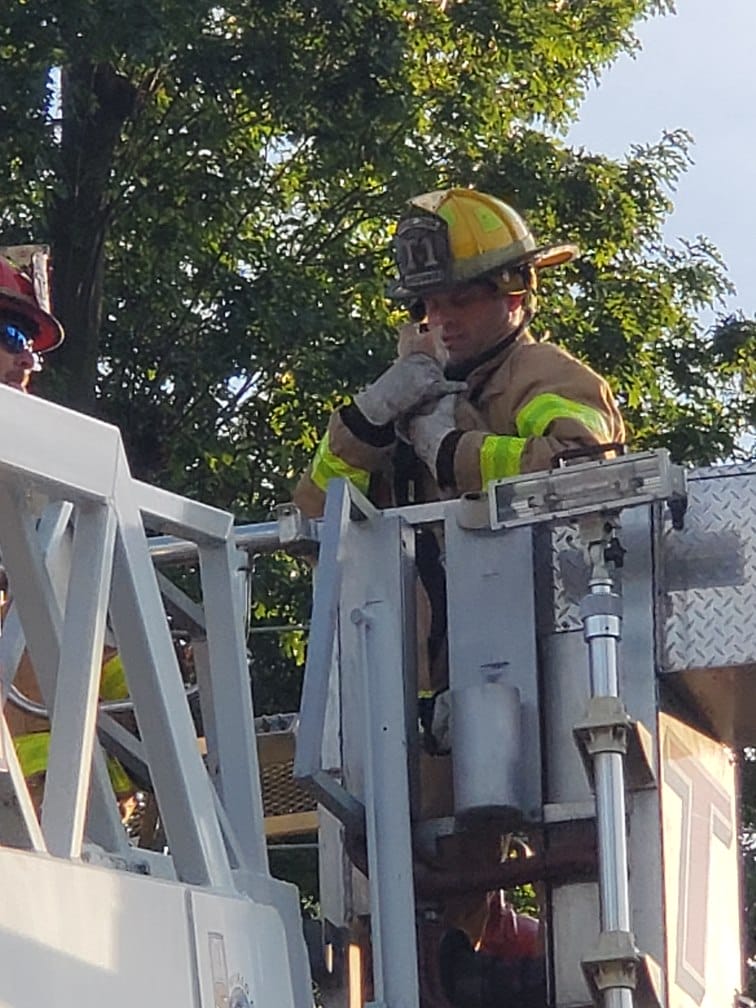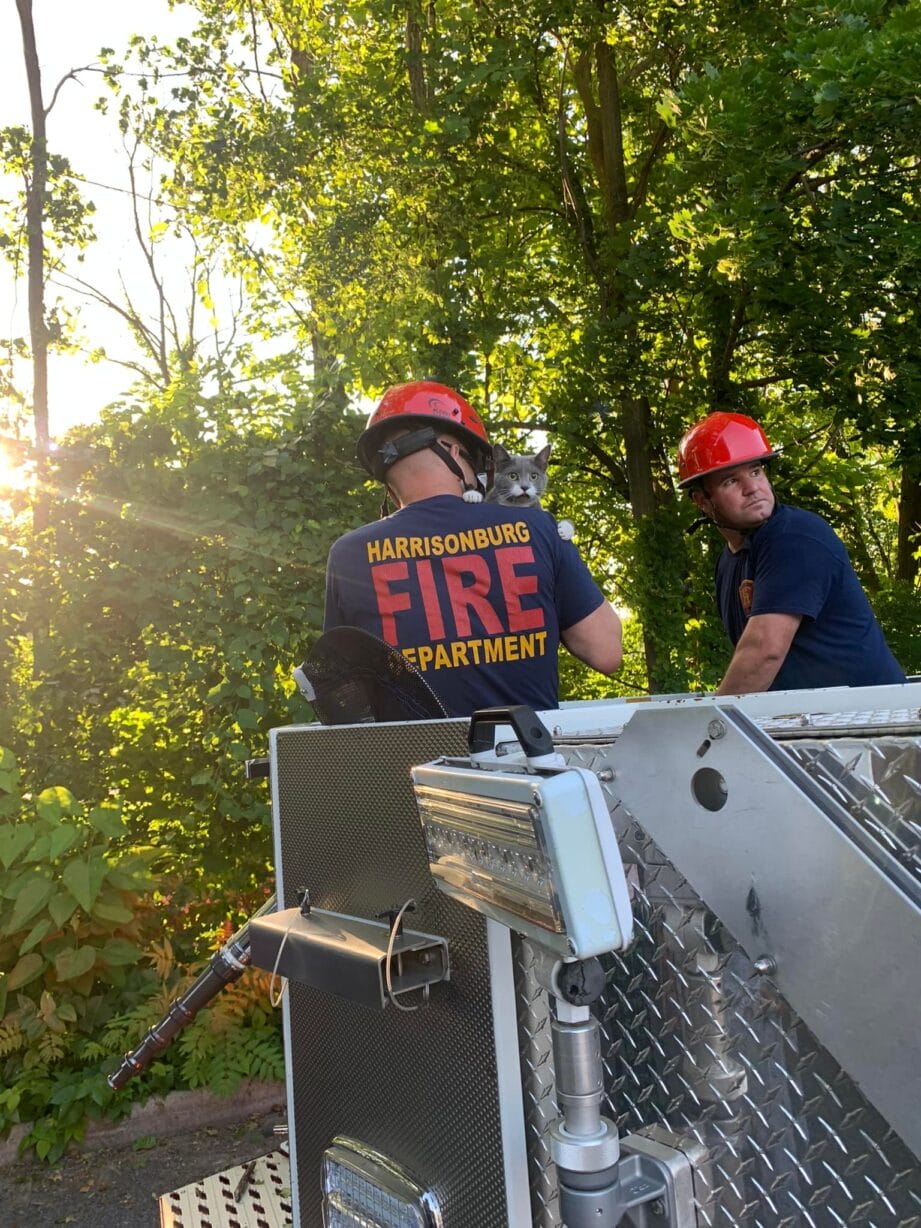
By Mike Grundmann
Ah, the good old days, when firefighters would rescue cats in trees.
Wait, they still do.
“It’s a very common practice nationally,” says Harrisonburg Fire Chief Matthew Tobia. “We get about half a dozen calls a year. We don’t give up. Firefighters are action-oriented and we love to solve problems.”
HFD will roll with an engine or ladder truck, but not with lights and sirens, and not at speed. Tobia says it’s OK to dial 911, but during business hours, use the business line. Sometimes animal control will get the call or be involved.
“People think it’s urban legend that we get cats out of trees,” he says. If kids try a rescue, “We will ask parents, ‘Do you value your kids or your pets more?’ They would actually have to stop and think a moment. You will see pet owners … become stuck themselves…or the owner falls. You get broken arms, legs, scrapes, head lacerations.”

And it’s not just cats. According to Deputy Chief of Operations Ben Zimmerman, there’ve been pet birds, snakes, iguanas and a teenager.
The Zimmerman household, by the way, has seven cats.
“They keep showing up and we can’t turn them away.”
Master Firefighter Tyler Burgoyne recalls another unusual case:
“I believe they were unsuccessful on getting a pet squirrel down. He had the home-field advantage.”
Burgoyne himself has five cats.
Lt. Joe Weaver says, “We keep 10 chickens.”
What’s going on here?
Tobia, with two cats and two dogs, says, “Many of our firefighters are also farmers, so they have a lot of animals in general.”

Crews generally won’t rescue gliders, kites or drones. One exception was ESPN Game Day at JMU in the fall, when they rescued a pet drone from the athletics department when it apparently ran out of power and landed not only on the roof of Wilson Hall but on its cupola, about 80 feet up.
There’s disagreement in the department about who holds the title of cat whisperer. Zimmerman supposes he could qualify, as could Burgoyne. Burgoyne won’t have it. Weaver says Lt. Chris Snyder is the one, but Snyder was out of town on training and not immediately available to defend himself.
Cats climb trees usually when chasing a delicious bird or being chased by something meaner, and they favor tall trees with lots of limbs.
“Cats, especially, are very, very good at climbing,” Zimmerman says. “They’re not so good at coming back down, the way their claws work.”
Many pet owners wrongly assume a treed cat is always an emergency.
“Put food and water at the base of the tree,” Tobia advises. “Standing at the bottom won’t increase the likelihood of coming down.”
“Wait 24 hours,” Zimmerman says. “When they get hungry enough, they will come back down.”
A treed cat may cry incessantly and, failing the above steps, the HFD will roll.
The aerial ladder truck can reach 100 feet, Weaver says. “But if limbs and forks are in the way … 50 to 60 feet is a good average … At times we got permission to cut limbs with the battery-operated chainsaw.”
The ladder truck is heavy and requires a solid surface, not backyard grass. A ground ladder can reach 35 feet, with spotters below to steady it.

In one rescue call, a 50-foot tree was standing about 300 feet from the road. Given that the ground was too soft for the ladder truck, Zimmerman told the owner, “I understand he’s your baby. If you really want this taken care of now, you might call a tree service.”
Rescuers have the option of using helmets, ropes and even pulleys. To protect against claws and teeth, they may wear the heavy-duty coat and gloves worn in structure fires, highly resistant to puncture and tearing.
But in one rescue, whatever glove Zimmerman was wearing wasn’t enough. “That guy’s little teeth” got through. The cat was “pretty agitated” and the owner unknown. The medical advice was, “You don’t have to get a rabies shot, but if you wait to show symptoms, you’ll die.” He got the three shots. In the old days, it would be about 20.
Usually, the cat hunkers down on a limb and, if the rescuer is unlucky, it waits until the last second to jump to an adjacent branch.
Zimmerman describes his technique:
“First, approach slowly. Allow them to see I’m not threatening. I’m on their level rather than looming above them. … If I’m up on a ladder 75 feet, one time I zipped up my coat, held it tight and snug. Earn their trust a little bit.”
Sometimes the cat will take the express elevator.
“I’ve seen cats fall 20 or 30 feet and survive,” Tobia says.
What if the animal has climbed a power pole, with the risk of electrocution? Call the utility.
Which is harder, a tall tree or the cliff of a quarry? Firefighters had to rappel for that one.
Zimmerman once witnessed, at a burning apartment building, a cat come flying through a third-floor window screen and drop about 20 feet.
In another residential fire, Zimmerman had to rescue a 5- or 6-foot iguana.
The big reward in tree rescues is how owners respond.
“They’re just overwhelmed,” Tobia says. “Crying, kids jumping up and down.”
Burgoyne says, “Most owners will post something nice on social media or kids will make thank-you cards.”
Weaver adds, “It’s a photo opportunity with firefighters and the ladder truck.”
Sometimes owners will offer donations, which Tobia says should be made instead to organizations like the SPCA or Harrisonburg Professional Firefighters Foundation.
This time of year, animal shelters are overrun. Groups like Cat’s Cradle will make adoptions easier by covering all or most costs.
“People wrongly assume cats must be outside,” Zimmerman says. “The safest place is inside the house.”
Mike Grundmann is a retired JMU journalism professor who previously worked as a reporter and editor for eight California newspapers, including the Los Angeles Times. He has produced 10 award-winning documentaries.
Thanks for reading The Citizen, which won the Virginia Press Association’s 2022 News Sweepstakes award as the top online news site in Virginia. We’re independent. We’re local. We pay our contributors, and the money you give goes directly to the reporting. No overhead. No printing costs. Just facts, stories and context. We value your support.












